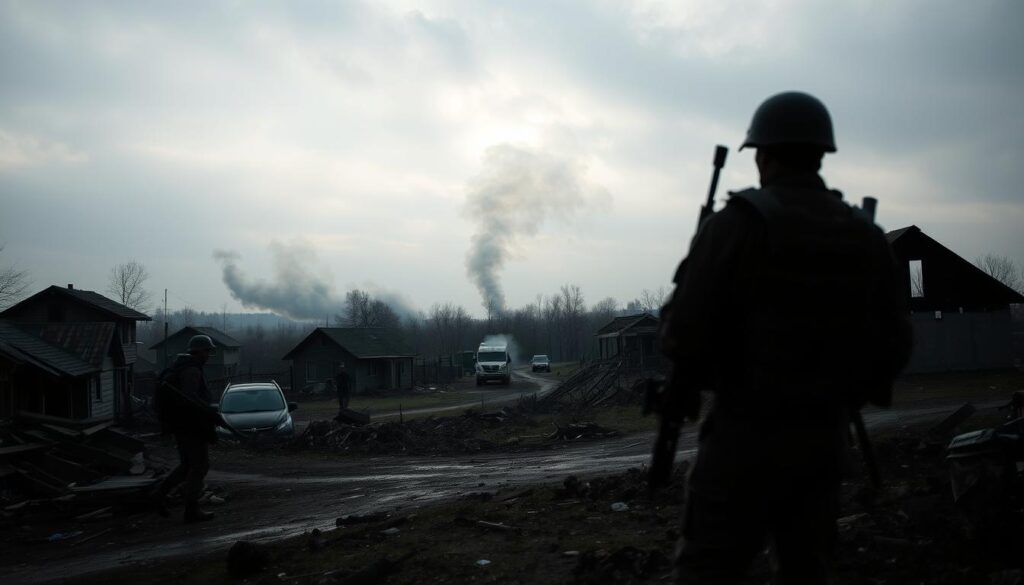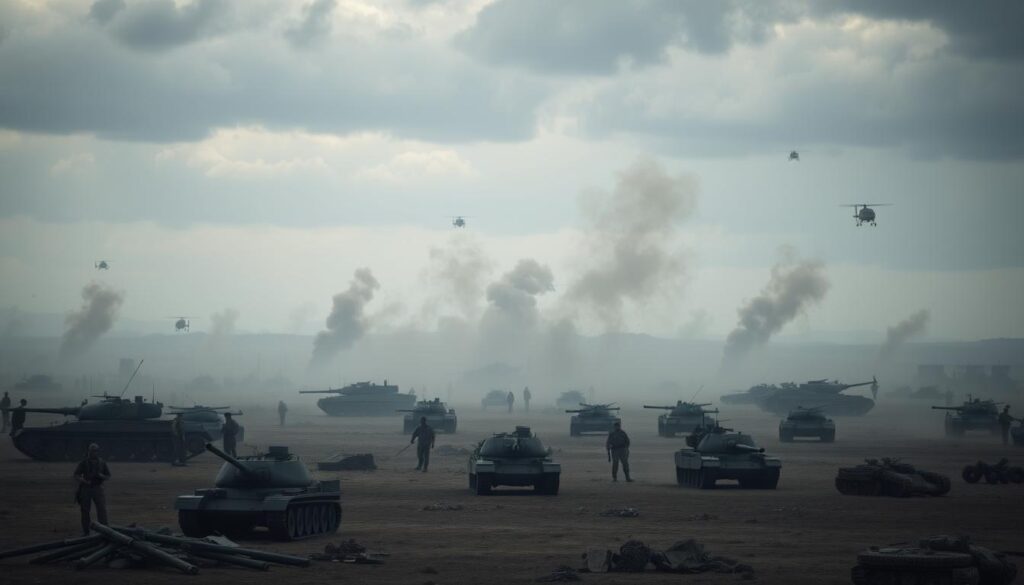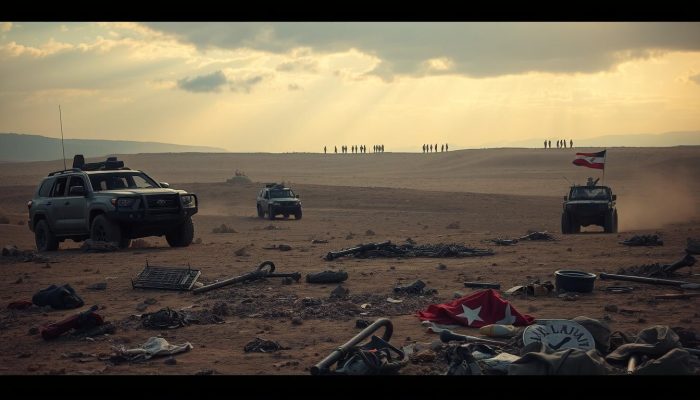British Defense Secretary Ben Wallace has made a shocking announcement. Russia faced its highest monthly casualties in the ongoing conflict with Ukraine in January 2023. Wallace revealed that Russia lost over 900 troops daily, showing a big increase in the war.
This news highlights the heavy burden the war is putting on Russia. It raises big questions about how long and intense the conflict will be. The world is watching closely, worried about what this means for global politics.
Key Takeaways
- Russia suffered its highest monthly casualties in the ongoing Russia-Ukraine conflict during January 2023.
- The Russian military endured a staggering loss of over 900 troops per day, marking a significant escalation in the conflict.
- The alarming statistic underscores the mounting pressure and toll the war is taking on the Russian forces.
- The international community is closely examining the implications of this military surge and its potential impact on the broader geopolitical landscape.
- The conflict’s intensity and duration raise concerns about the future of the Russia-Ukraine war and its global repercussions.
Recent Surge in Russian Military Losses: Breaking Down the Numbers
The Russia-Ukraine conflict has led to a big increase in Russian military losses. This has raised worries about the Russian armed forces’ readiness and strength. Looking at the daily casualty rates, where the casualties are happening, and how it affects Russian military readiness helps us understand the war’s changing nature.
Daily Casualty Rates and Combat Intensity
Reports from military intelligence show Russian military daily casualties have hit new highs. The battles, especially in the Donbas, have been very tough on Russian troops. It’s said that daily losses can be hundreds or even over a thousand. This constant loss is pushing the Russian military’s manpower and resources to their limits.
Geographic Distribution of Casualties
The places where Russian casualties are happening have also been looked at closely. The Donbas region has seen the worst fighting, but territorial disputes and civilian casualties on other fronts add to the total loss. The Russian military’s fight to keep control over disputed areas and deal with NATO expansion has made their job very hard.
Impact on Russian Military Readiness
The ongoing losses have clearly weakened the Russian military’s readiness and ability to fight. Many experienced soldiers and officers have been killed or hurt, affecting the Russian forces’ ability to work together and make decisions. This has big implications for the future of the conflict and Russia’s chances of winning.
“The scale of the Russian military’s losses in Ukraine is staggering, and it is clear that the Kremlin is struggling to maintain its combat power in the face of a determined Ukrainian resistance.”
Key Factors Behind Russia-Ukraine Conflict Escalation
The Russia-Ukraine conflict is a complex issue. It’s driven by many factors, like energy security, economic sanctions, and international law violations. These have greatly affected the conflict’s path and intensity.
Energy security is a big concern. Russia’s control over European energy markets gives it a lot of power. This has raised worries about energy reliability. The risk of gas and oil supply disruptions has made tensions worse.
Economic sanctions on Russia are another important factor. These sanctions aim to stop Russia’s military actions. They’ve hit Russia’s economy hard. The economic pressure has, in turn, shaped Russia’s strategic calculus and contributed to the escalation of the conflict.
Also, Russia’s actions that break international law have made things worse. These actions, like taking Crimea and sending troops to Donbas, have been widely criticized. They’ve increased diplomatic tensions and fueled the conflict’s escalation.
“The interplay of these factors has created a complex and volatile situation, making the path to a lasting resolution increasingly challenging.”
Understanding the conflict’s drivers is key to finding a lasting solution. As the situation continues, knowing how these factors work together is crucial.

Strategic Analysis of Russian Military Operations
The conflict in Ukraine is ongoing, and a closer look at Russian military operations shows changes. Russia’s forces have adapted their strategies to face new challenges. This analysis explores the tactical shifts, intelligence, and obstacles Russia faces in keeping up its military strength.
Tactical Changes in Russian Forces
Russia has made changes in its military tactics due to high casualties and logistical issues. The Russian army now focuses more on artillery to weaken Ukrainian defenses before attacking. Russia also uses elite units and special forces in key areas to gain an edge in the military escalation.
Intelligence Assessment and Battlefield Reports
Intelligence from various sources shows a complex conflict picture. Reports from the battlefield say Russia’s forces are finding it hard to keep the momentum. The Ukrainian military often holds strong against territorial disputes. These reports also point out Russia’s challenges in coordinating its forces and adapting to the battlefield’s changes.
Military Equipment Losses and Replacement Challenges
- Russia has lost a lot of military equipment, like tanks and aircraft, as the Ukraine conflict goes on.
- Replacing this equipment is a big challenge for Russia, due to sanctions and supply chain problems.
- The refugee crisis from the conflict also strains Russia’s resources, making it harder to keep and replace military forces.
The strategic analysis shows that Russia’s military in Ukraine has evolved, but big challenges remain. The mix of tactical changes, intelligence, and equipment losses shows the conflict’s complex and changing nature.

“The situation on the ground in Ukraine remains fluid, with both sides adapting their tactics and strategies to gain the upper hand. Russia’s military is facing increasing difficulties in sustaining its operations, underscoring the complexity of this territorial dispute.”
International Response and NATO’s Position
The world has come together to face the growing tensions between Russia and Ukraine. NATO, or the North Atlantic Treaty Organization, is playing a key role. Its member countries are crucial in shaping the global response.
NATO has led in diplomatic and economic actions to tackle the crisis. The alliance has put tough economic sanctions on Russia. These sanctions target its banks, energy, and top officials. The U.S., European Union, and other allies have followed suit, showing a united front against Russia.
NATO has also worked to boost Ukraine’s military strength. The alliance has given Ukraine weapons, ammo, and training. This support, along with Ukraine’s bravery, has helped the country fight back against Russia.




